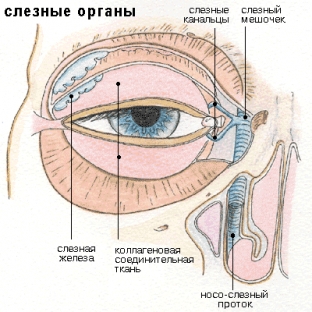Acute inflammation of the lacrimal gland, or dacryoadenitis, is often the only sign of a serious infectious disease in a patient that occurs in an asymptomatic, lubricated or atypical form. This inflammation can be triggered by mumps, herpes virus, infectious mononucleosis, influenza, some sexually transmitted infections and other pathogens. The disease has a favorable prognosis, but without adequate therapy it can have complications or become chronic.
Why does inflammation of the lacrimal gland happen
Dacryoadenitis almost always occurs against the background of an already existing infectious disease – for example, mumps, pneumonia, influenza, scarlet fever or other infections. This acute inflammation of the lacrimal gland can affect one eye, and in parotitis it affects both eyes.
The symptoms of dacryoadenitis are quite distinct, and the doctor can make a diagnosis based on the clinical picture of inflammation of the lacrimal gland. The clearest of these diagnostic features – S-symptom, when, due to a swollen gland, the upper eyelid acquires a curve in the form of a horizontal English letter "S". Other typical symptoms of dacryoadenitis:
- temperature rises,
- general symptoms of intoxication appear – weakness, weakness, headache,
- the upper eyelid is very swollen, swollen, increases in size,
- The swollen eye hurts a lot, especially in the area of the outer corner, its movement is limited,
- lymph nodes behind the ears are enlarged,
- edema may move to the temporal part.
When examining the patient, if the upper eyelid is pulled back, an enlarged lacrimal gland and swollen conjunctiva are visible, palpation of the eye is very painful, the patient practically does not allow touching the eyelid. Eye swelling progresses rapidly. Sometimes the pressure on the eyeball becomes so strong that the patient complains of double vision.
The danger of disease progression is that without immediate treatment, especially if the body's defenses are weakened, inflammation of the lacrimal gland can be complicated by an abscess or phlegmon that covers the orbit of the eye and can provoke meningitis.
How to treat inflammation of the lacrimal gland, prognosis of the disease
Usually the prognosis for inflammation of the lacrimal gland is quite favorable, recovery occurs in about two weeks. The chronic form of dacryoadenitis develops, as a rule, against the background of diseases of the hematopoietic system, tuberculosis, venereal infections, but may also be the result of acute inflammation of the lacrimal gland.
 In case of chronic dacryoadenitis, you can palpate in the region of the lacrimal gland a dense, deep swelling, and see a protrusion on the inside of the upper eyelid. In this case, no pronounced inflammation develops, the skin over the swelling does not change.
In case of chronic dacryoadenitis, you can palpate in the region of the lacrimal gland a dense, deep swelling, and see a protrusion on the inside of the upper eyelid. In this case, no pronounced inflammation develops, the skin over the swelling does not change.
Treatment of inflammation of the lacrimal gland begins, first of all, with the treatment of the disease that caused the development of dacryoadenitis. In parallel, antibiotic therapy is prescribed, if necessary – analgesics and antiallergic drugs to relieve swelling. The eye is washed with antiseptic solutions, corticosteroid solutions are dripped into the conjunctival sac and antibacterial ointments are applied at night. It may be recommended to use UHF therapy, a means to strengthen the immune system. If an abscess has developed, it is necessary to open the abscess and drain it. The treatment of chronic dacryoadenitis consists in the treatment of the underlying disease, dry heat procedures may be useful for the eye.
Thus, timely antibiotic therapy and treatment of an infectious disease that caused inflammation of the lacrimal gland will help prevent the development of complications and chronicity of the process.







Add a comment